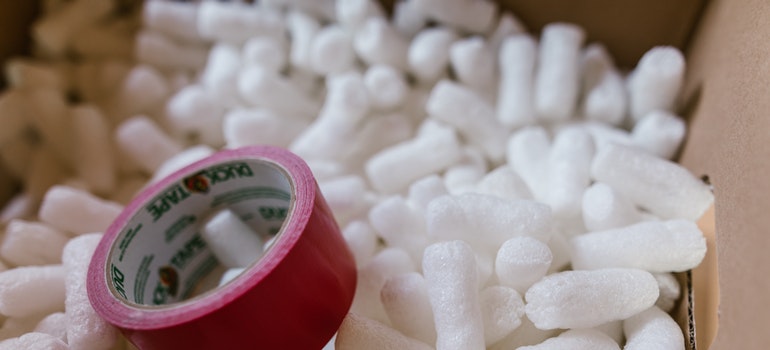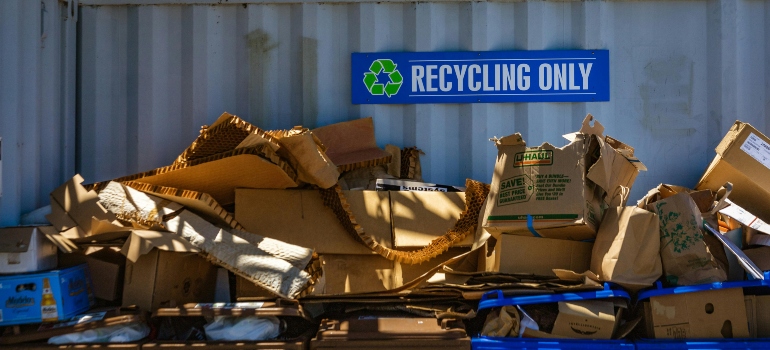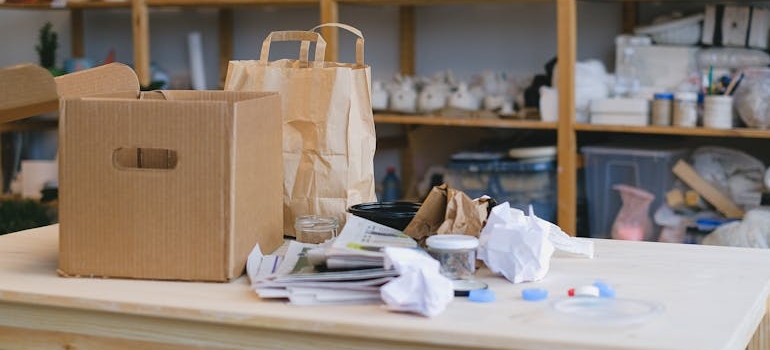Sustainable Alternatives to Traditional Packing Materials
Every product shipped, stored, or transported requires some form of packaging to ensure its protection and integrity. However, traditional packaging materials often come at a high environmental cost. Plastic, styrofoam, and non-recyclable composites fill our landfills and oceans, posing serious ecological risks. Fortunately, greener solutions are getting more and more easily available, providing the same protection while reducing environmental harm. Therefore, our team at Hansen Bros. Moving & Storage will look at several sustainable alternatives to traditional packing materials. Each alternative can help our clients make more responsible packaging choices without sacrificing functionality!
Read more: Sustainable Alternatives to Traditional Packing MaterialsEco-Friendly Packing Solutions for the Moving Industry
Movers rely heavily on packing materials to ensure that items reach their destination safely. However, traditional materials like plastic wrap, bubble wrap, and styrofoam contribute to long-term environmental waste. Switching to sustainable alternatives allows movers to reduce their environmental footprint without compromising the quality and reliability clients expect:
- Biodegradable Plastics in Place of Traditional Plastic Wraps: Moving companies use plastic wraps extensively to secure furniture, prevent scratches, and protect against dust and dirt. Biodegradable plastic wrap can serve the same purpose but decomposes naturally.
- Mushroom Packaging Instead of Styrofoam: Mushroom-based packaging is among the ideal sustainable alternatives to traditional packing materials, offering the same level of protection but breaking down quickly.
- Paper-Based Cushioning as a Bubble Wrap Replacement: Paper-based cushioning materials, such as honeycomb paper or shredded paper, provide an eco-friendly way to protect delicates.
- Biodegradable Air Pillows for Void Filling: Moving boxes often have empty spaces that require fillers to prevent items from shifting. The pillows provide the same shock absorption but leave no lasting waste.
- Recycled Plastic Bags for Organizing Small Items: In the moving industry, plastic bags are frequently used to group small or loose items, like screws, cords, or hardware. Recycled plastic bags allow movers to support waste reduction without sacrificing utility.
- Sustainable Adhesives for Sealing Boxes: Packaging tape is essential in the moving industry to secure boxes, but starch-based adhesives and water-activated tape can provide a secure seal while being more sustainable.
- Mono-Material Packaging for Specialty Moving Cases: Some moving companies use custom cases for fragile items, which are often made from a mix of materials. Mono-material packaging like wooden shipping crates in Seattle helps movers minimize their environmental impact.
Adopting sustainable options allows moving companies to appeal to eco-conscious clients while aligning with global sustainability goals!
Plastic Packaging vs. Biodegradable Plastics
Plastics are pervasive in packaging due to their low cost and durability. However, they come with an immense environmental cost, as they persist for hundreds of years in landfills and oceans. To tackle this, biodegradable and sustainable alternatives to traditional packing materials offer a way to reduce plastic waste and lessen its impact on the environment.

Traditional Material: Plastic Packaging
Plastic packaging is one of the most widely used materials due to its durability, versatility, and cost-effectiveness. This synthetic material is used in everything from food containers to protective packaging, ensuring products stay safe from damage or contamination.
However, plastic takes hundreds of years to decompose, often ending up in landfills or oceans where it harms wildlife and ecosystems. The global scale of plastic pollution has made the search for alternatives crucial.
Eco-Friendly Alternative: Biodegradable Plastics
Biodegradable plastics are made from renewable resources like cornstarch, cassava, and sugarcane, which break down more easily in natural environments. Unlike traditional plastics, which persist for centuries, biodegradable plastics decompose over months or a few years, especially in composting conditions.
By choosing biodegradable options, Washington movers and clients can help reduce the plastic waste clogging our oceans and landfills. Cornstarch-based packaging, for example, provides a durable, eco-friendly solution that doesn’t compromise performance.
Styrofoam vs. Mushroom Packaging
Styrofoam’s lightness and insulation make it popular, but it’s one of the least sustainable materials. Non-biodegradable and rarely recycled, styrofoam fills landfills and pollutes oceans. Mushroom-based packaging offers a natural, compostable solution with the same protective qualities but without long-term environmental consequences.
Traditional Material: Styrofoam
Styrofoam, also known as expanded polystyrene (EPS), is a popular choice in packaging due to its lightweight structure, cost-effectiveness, and excellent insulating properties. Its ability to absorb shock makes it particularly useful for shipping fragile items, electronics, or temperature-sensitive food and beverages. In the United States alone, manufacturers produce over 3 million tons of EPS annually, much of which is used in the packaging industry.
However, styrofoam poses severe environmental challenges. It is non-biodegradable, taking up to 500 years to decompose fully, which leads to massive accumulation in landfills and natural habitats. Additionally, styrofoam’s light structure allows it to break apart easily and blow into waterways, where it endangers marine and wildlife by leaching harmful chemicals and contributing to plastic pollution. Because of these issues, finding sustainable alternatives to styrofoam is essential in reducing packaging waste and its lasting environmental impact.
Eco-Friendly Alternative: Mushroom Packaging
Mushroom packaging, made from mycelium (the root structure of fungi), offers a completely biodegradable alternative to styrofoam. Mycelium binds agricultural waste into durable, moldable forms that can protect products just as well as styrofoam but without the environmental cost. Once disposed of, mushroom packaging breaks down naturally within weeks, enriching the soil rather than polluting it.

Plastic Bubble Wrap vs. Paper-Based Cushioning
Plastic bubble wrap is iconic but adds significantly to landfill waste, as it’s difficult to recycle. Paper-based cushioning provides a biodegradable solution that also protects items effectively. Transition supports recycling efforts and reduces the carbon footprint associated with plastic bubble wrap.
Traditional Material: Plastic Bubble Wrap
Plastic bubble wrap has been a staple for protecting fragile items during shipping, providing an effective cushioning barrier. In 2021, the protective packaging market was estimated to be worth over $32 billion globally, with bubble wrap comprising a significant portion of that. Despite its usefulness, bubble wrap is made from polyethylene, a type of plastic that is challenging to recycle due to its thin, flexible structure, which most recycling facilities are unable to process effectively.
As a result, much of the bubble wrap produced ends up in landfills, where it can persist for up to 500 years before breaking down. During this time, it contributes to the global plastic pollution crisis, especially when it escapes into waterways and ecosystems, posing severe risks to wildlife that may ingest it or become entangled. Finding alternatives to bubble wrap can help reduce these long-term environmental impacts while still providing the necessary protection for shipped items.
Eco-Friendly Alternative: Paper-Based Cushioning
Paper-based cushioning, such as honeycomb paper, shredded kraft paper, or molded pulp, is a sustainable option for shipping companies in Seattle that provides excellent shock absorption. Unlike plastic bubble wrap, paper-based cushioning is biodegradable, compostable, and can often be recycled with ease. Using paper-based solutions not only reduces plastic waste but also supports a circular economy, as the paper can be repeatedly recycled and eventually returned to nature through composting.
Plastic Air Pillows vs. Inflatable Biodegradable Air Pillows
Plastic air pillows are efficient for filling voids but contribute to plastic pollution. A biodegradable option reduces waste and is compostable, breaking down naturally without residue. These inflatable biodegradable pillows offer the same protective benefits while aligning with sustainable practices.
Traditional Material: Plastic Air Pillows
Plastic air pillows commonly fill empty spaces in packages, preventing items from shifting during transit. Lightweight and effective, these pillows protect goods during shipping but are typically from non-recyclable plastic, adding to global plastic waste.
In 2020, the U.S. alone generated over 14.5 million tons of plastic packaging waste, much of which came from single-use items like air pillows. Because they are rarely accepted by recycling facilities, these pillows often end up in landfills, contributing significantly to environmental pollution with each use.
Eco-Friendly Alternative: Inflatable Biodegradable Air Pillows
Biodegradable air pillows, often made from plant-based materials like cornstarch, provide the same protective cushioning but break down more readily in natural environments. These pillows are compostable, which means they will decompose naturally without leaving microplastics or toxic residues. Switching to biodegradable air pillows protects the items while also protecting the planet.

Plastic Bags vs. Recycled Plastic Bags
Plastic bags are among the most discarded items, often ending up in oceans or landfills. While they’re convenient, they have a long-lasting environmental impact. Recycled plastic bags offer a more sustainable choice, conserving resources and reducing the need for new plastic production.
Traditional Material: Plastic Bags
Plastic bags are widely used in packaging because of their lightweight nature, low cost, and flexibility. Despite their convenience, plastic bags have a severe environmental impact due to their non-biodegradability. Many of these bags end up in oceans and natural landscapes, where they harm wildlife and contribute to plastic pollution.
Eco-Friendly Alternative: Recycled Plastic Bags
Recycled plastic bags reprocess used plastics, reducing the demand for virgin plastic and diverting waste from landfills. Using recycled plastics conserves resources and reduces the environmental footprint associated with producing new plastic. When they choose recycled plastic bags, clients and freight companies in Seattle can help close the loop in the plastic life cycle, presenting a greener solution that still meets functional needs.
Non-Recyclable Composite Packaging vs. Mono-Material Packaging
Mixed materials in composite packaging make recycling nearly impossible, which increases waste. In contrast, mono-material packaging uses a single recyclable material, simplifying recycling and promoting a circular economy. Switching to mono-material packaging can reduce landfill overflow and boost recycling efficiency.
Traditional Material: Non-Recyclable Composite Packaging
Composite packaging combines multiple materials, like plastic, metal, and paper, to provide superior protection and insulation. Unfortunately, these mixed materials are difficult to separate and recycle, leading to their disposal in landfills. Composite packaging is most common for items like food pouches and beverage cartons, which, despite their utility, have a heavy environmental toll.
Eco-Friendly Alternative: Mono-Material Packaging
Mono-material packaging, as the name suggests, consists of a single material, making it easier to recycle. Moving companies and HB move management can simplify waste sorting and encourage consumers to recycle by utilizing packaging that only uses one type of recyclable material. As a result, mono-material packaging reduces landfill waste and supports a more efficient recycling industry.

Petroleum-Based Inks vs. Sustainable Inks
Conventional inks emit VOCs and use petroleum, harming both people and the environment. Sustainable inks reduce VOC emissions and are biodegradable, making them safer to use. Reversing to eco-friendly inks aligns with recycling goals and is safer for workers and consumers.
Traditional Material: Petroleum-Based Inks
Traditional printing inks, often made from petroleum, contain volatile organic compounds (VOCs) that can be harmful to the environment and human health. Printed packaging extensively uses these inks, but their production and disposal harm the environment, especially when people discard or compost the packaging.
Eco-Friendly Alternative: Sustainable Inks
Sustainable inks, such as soy-based or water-based inks, provide an environmentally friendly alternative to petroleum-based inks. Derived from renewable sources, these inks produce fewer VOC emissions, making them safer for the environment and people. Opting for sustainable inks helps reduce pollution while making packaging more compatible with recycling and composting systems.
Sustainable Packaging Choices that Make a Difference
As we look at the world of packaging, it’s clear that sustainable alternatives can provide practical and eco-friendly solutions without sacrificing quality. Transitioning from traditional materials to biodegradable plastics, mushroom packaging, paper-based cushioning, and more, we can significantly reduce the environmental impact of packaging. These alternatives help conserve resources and support a more sustainable, circular economy where we continually repurpose materials and actively reduce waste.
For businesses and individuals alike, making mindful choices about packaging materials can help create a brighter future, where our products don’t come at the cost of the planet. Simply by incorporating sustainable alternatives to traditional packing materials into our daily practices, we can drive change, reduce pollution, and foster a healthier world for future generations.
Why Choose Us
History
Hansen Bros. Moving & Storage is locally owned and operated by the same family for four generations, since 1890. We have a well-established reputation for service quality and reliability with a high percentage of repeat household and commercial clients.
Professionalism
We’re a certified ProMover by the American Moving and Storage Association with A+ rating with the Better Business Bureau, voted “Best in Western Washington” in 2009 and from 2011 to 2016 by KING5. Our company is fully licensed and insured and member of WMC and AMSA.
Value
Hansen Bros. Moving & Storage provide free, no-obligation in-home estimate and competitive rates, including low minimum rates for shipments moving under 300 miles. We’ve set a refund policy for unused packing materials and three Puget Sound locations to help clients save on travel fee costs.



